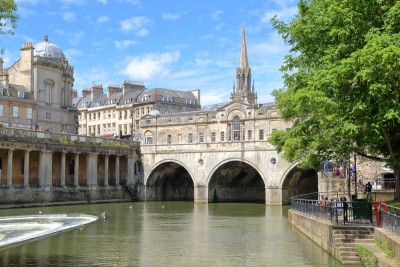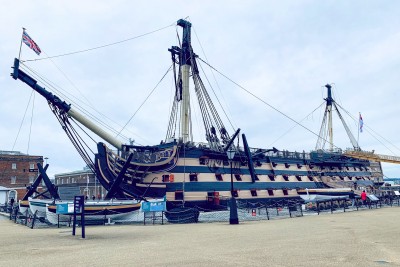The 26 top things to do on the Isle of Man

The Isle of Man, a small self-governing island sitting in the middle of the northern half of the Irish Sea, is a fascinating short-break destination.
There are lots of things to do on the Isle of Man.
There are picturesque seaside towns and bays dotted along its rugged coastline, ancient castles, and some heritage railways that present scenic views of the rolling countryside and, in places, dramatic landscape. The island also boasts the largest original waterwheel in the world that is still in operation (the Great Laxey Wheel).
The Isle of Man is only small (the island is only just over 570 square km in size). It’s therefore possible to see many of these attractions on a short break with some careful planning.
We visited for 2 nights and stayed in the island’s capital, Douglas. Below are the things to do in the Isle of Man that we fitted into our trip, as well as some other attractions you might want to consider.
There is also some practical information to help you plan your visit and some unique facts about the island.
This post contains affiliate links
About the Isle of Man
– The Isle of Man is a British Crown dependency in the middle of the northern half of the Irish Sea. The island sits almost equidistant from England, Scotland, Northern Ireland, and Wales, although Scotland is the nearest.
– The Isle of Man is small. Its entire population only numbers around 85,000, and the island covers just over 570 square km.
– The island has its own Manx language, which is derived from the same linguistic family as Irish and Scottish Gaelic.
– The island is known for its Manx cats. These have either no tail or else a very short tail.
– The Isle of Man has the largest original waterwheel in the world that is still in operation – the Great Laxey Wheel.
– Snaefell is the island’s highest point, and on a clear day, offers great views of all four countries in the United Kingdom.
– There are several heritage railway lines here – it’s a great place for train buffs! These include an electric railway, a steam train, trains that go up the mountain and through glens, and horse drawn trams.
– The three brothers who found fame as The Bee Gees were born here, and a statue of them is at the south end of Douglas Promenade.
– Actor and comedian Norman Wisdom lived on the Isle of Man for over 30 years. There is a hotel bar named after him and a seated statue of him on a bench at the entrance.
– The Isle of Man hosts its annual TT motorbike race over a two-week period from late May to mid-June.
Where is the Isle of Man?
The Isle of Man is part of the British Isles. It is located in the Irish Sea between the British mainland which sits to the east and the Republic of Ireland and Northern Ireland to the west.
The island is almost equidistant from England, Scotland, Northern Ireland, and Wales. The nearest point is in Scotland: Point of Ayre at the northern tip of the Isle of Man is about 25 km from Scotland’s Burrow Head.
The Isle of Man’s proximity to all four countries means that on a clear day, you can get unparalleled views of the coastline of every country that makes up the UK from the top of Snaefell, the island’s only mountain.
Where is Douglas?
Located on the island’s eastern side facing England, the capital, Douglas, is a great base to explore the Isle of Man on a short getaway. This is because it’s a hub for transportation and a hopping off point between the two most important heritage railways – the Steam Railway and the Manx Electric Railway.
Douglas is the largest of the island’s towns, and there are lots of things to do here. While the centre is relatively compact (and quite hilly in parts), you can, in fact, walk a fair distance along its seafront (Douglas Promenade). This runs the length of the town’s sweeping beach on Douglas Bay.
How to get to the Isle of Man
By air
Because of its relatively small size, the Isle of Man has only one airport – Ronaldsway Airport. This is located in the south of the island, just north of Castletown, and only about 30 minutes from Douglas by bus. On the way to and from the airport, you pass over the Fairy Bridge, and it is a superstition here to ‘greet the fairies’ as you drive over it.
The Isle of Man’s air terminal is served by a number of airlines, notably Aer Lingus, British Airways, EasyJet and Loganair. There are scheduled flights from several airports in the UK and the Republic of Ireland, including Belfast, Birmingham, Dublin, Edinburgh, Liverpool, London and Manchester.
We flew with EasyJet from London Gatwick. The flight time was about an hour. You are then through arrivals in minutes as the airport is tiny.
By sea
You can also travel to the island by sea (although note that the boats can be subject to cancellation or delay when the weather conditions are particularly poor, as we discovered when we visited).
When weather conditions are favourable, arriving at the Isle of Man Sea Terminal by either Fastcraft or ferry is a popular entry point to the island because it means you can bring your car over. There are services to and from Heysham and Liverpool in England, Dublin in the Republic of Ireland, and Belfast in Northern Ireland.
Timetables for travelling can vary depending on what time of year you decide to visit. However, to give an example, if you sail from Heysham, there are 13 sailings weekly and the journey time is 3 hours and 45 minutes.
Alternatively, if you leave from Liverpool, there are 11 sailings every week, and the journey time is 2 hours and 45 minutes. This is much faster as you are using the Fastcraft service.
How to get to Douglas
If you are arriving at the Isle of Man Sea Terminal by Fastcraft or ferry, it is a straightforward short walk for foot passengers into the centre of Douglas. Importantly, the sea terminal is where you’ll find the Isle of Man Welcome Centre.
If you are arriving on a flight from the United Kingdom or the Republic of Ireland at Ronaldsway Airport, getting into town is easy. You are spoilt for choice, as seven buses (1, 1A, 1H, 2, 2A, 11, and 11A) pass through the arrivals/departure drop-off to and from Douglas.
There are quite a few stops where you can get off in the town centre, but as Douglas isn’t big, it won’t take long to find your bearings.
How to get around the Isle of Man
If you don’t have access to a car while you’re on the island, it is possible to get to the main attractions by public transport. Isle of Man Transport operates an extensive bus service under the bus Vannin brand. This covers the main places of interest on the island, so getting around is incredibly easy.
It’s worth noting that one of the main attractions on this island is its very unique heritage rail network. So, you can not only use the railways to get around, but also as an experience in itself.
There are three main railways that you must fit into your days on the Isle of Man, but there are also others you can explore while there. However, bear in mind that these don’t run year-round. The operating dates are generally from mid-March through to late October. It’s important to remember this when planning things to do in the Isle of Man.
One of the lines is the Manx Electric Railway. This runs from Derby Castle at the northern end of Douglas Promenade along the island’s eastern coastline up to the Ramsey terminus in the northeast.
Along the way, you will pass through Groudle Glen and Laxey (where you’ll find the Laxey waterwheel). This is where you need to hop off and catch the Snaefell Mountain Railway, which snakes its way up to the highest point on the Isle of Man.
The third heritage route is the Steam Railway that runs from Douglas Station, a stone’s throw from the harbour, to Port Erin in the southwest.
You can also book day tours that will take you around parts of the island and that might be better value for money if you are travelling in a small group. Click here for more information.
The Isle of Man Explorer ticket
Depending on how many individual journeys you make, you may want to consider purchasing a Go Explore ticket.
This covers all the main heritage railways – the Manx Electric Railway, the Snaefell Mountain Railway, the Isle of Man Steam Railway, and the Douglas Bay Horse Tramway (a horse-drawn tram that runs along part of Douglas Promenade) – for your chosen number of days (1, 3, 5 or 7 consecutive days). It also covers all scheduled bus services.
As of April 2023, an adult 1 day ticket is £19 and a 3 day ticket is £39. If you want to pack in a lot of travel, the ticket is really handy and good value for money.
The top things to do on the Isle of Man
There’s a lot to do on a short break here. Below are 26 of the best things to do on the Isle of Man.
Explore the capital, Douglas
While on the Isle of Man, you should spend some time in its capital. However, Douglas isn’t big by any stretch, so you could explore it in just a few hours if time is tight.
The city’s layout is quite varied. The downtown section between Victoria Street and North Quay next to Douglas Harbour has some of the town’s oldest buildings and has a certain charm.
This is especially true of the quayside, with its boats bobbing up and down. There are quite a few bars and eateries in this criss-cross of streets, so it’s a good place to head to if you want some refreshment.
Prospect Hill, where you will find the House of Keys (the directly elected lower house of the Isle of Man’s parliament) is fairly steep and features some elegant period buildings.

This leads down to and becomes Victoria Street, which connects with Douglas (Loch) Promenade at the seafront.
This stretch features some high street stores and banks. However, the main shopping thoroughfare is on Strand Street, which runs north from Victoria Street and connects with Douglas (Harris) Promenade at the Gaiety Theatre.
Walk along the Douglas Promenade
While in Douglas, make sure you head down to the seafront. On a fine day, you can have a lovely walk along the length of the promenade from Douglas Promenade Gardens up to Derby Castle.
This long stretch takes you past impressive townhouses on your left and Douglas Bay on your right.

On the way, you’ll pass the statue of the Bees Gees, who were born on the island, and the Gaiety Theatre (with the bar in the hotel next door commemorating one of the island’s most famous residents, Norman Wisdom). There is also Villa Marina, an entertainment centre and the towering war memorial to the Isle of Man’s fallen soldiers.
Hop on the Douglas Bay Horse Tramway
On your walk along the promenade, you’ll see the Douglas Bay Horse Tramway pass you.
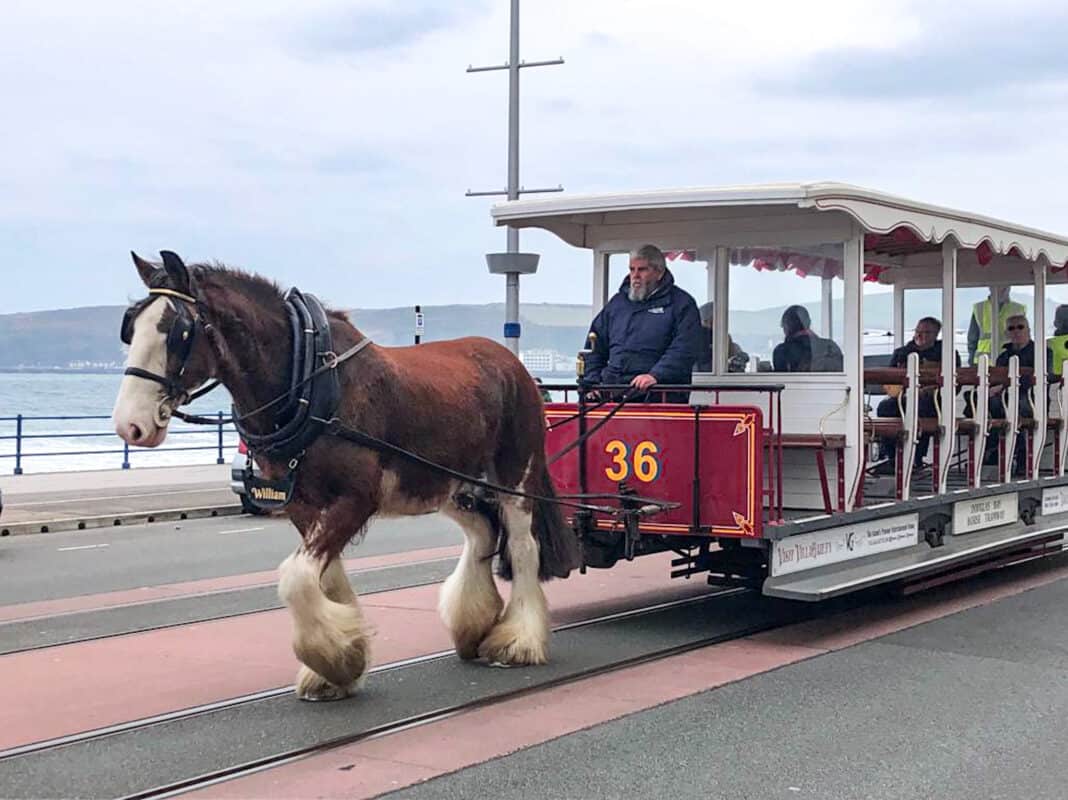
This short service of horse-drawn trams runs from opposite Villa Marina to Derby Castle at the northern end of the promenade. So you can hop on if this is something you’d like to do (it is included if you’ve bought the Go Explore ticket).
From the Derby Castle end of the route, you can pick up the Manx Electric Railway north to Groudle Glen, Laxey, Snaefell, and Ramsey.
Ride the Manx Electric Railway
Another attraction you must fit into your trip to the Isle of Man is the 17 mile journey on the Manx Electric Railway from Derby Castle in Douglas to Ramsey. It runs from mid-March to the end of October each year.
Arguably, it’s the most scenic of the heritage railway lines on the island, and it’s a fun way to get around, particularly if you like trains. You can sit in open carriages when the weather is good, and there are also enclosed carriages for more inclement days.

The Manx Electric Railway travels along the eastern coastline and through varied scenery, including glens and hills. At Bulgham Bay, the electric tram rides quite close to cliff edges (don’t worry, you are quite safe), and you are rewarded with fantastic views across the sea towards England.
The Manx Electric Railway is also significant because there are some great stop-offs on the way to Ramsey. We travelled up to Laxey, then switched to the mountain train before returning and travelling up to Ramsey.
Go up to the highest peak on the island
When you get off the Manx Electric Railway at Laxey, you can pick up the Snaefell Mountain Railway. This takes you to the highest point on the island which is over 2,000 feet above sea level.
When planning your trip to the Isle of Man, make sure you definitely include this. Although, as already mentioned, remember that the service only operates from mid-March to late October each year.

The Victorian-era electric tram snakes its way up to the mountain’s summit in about 30 minutes. On the way, you can see the Great Laxey Wheel in operation and the former Snaefell Mine. You also cross the road where the annual motorbike TT racing takes place. On a clear day, the views on the way up are pretty incredible. You can see England, Northern Ireland, Scotland and Wales from the top.
Once you’ve walked around at the top and admired the spectacular views, there is a café by the terminus where you can stop off for something to eat and drink and a toilet break.
You can also buy a unique Snaefell postage stamp here. Stick this on your postcard alongside an Isle of Man stamp and post it in the small box in the café. It’ll then be taken by train down to the local post office and onwards.
Visit Laxey and ride the Great Laxey Mine Railway
Another spot you should explore if you have the time is the small town of Laxey. The former fishing town (apparently, its name comes from the Norse for ‘salmon river’) down the hill on the seafront is worth wandering around. Laxey beach is here which is a mix of both sand and pebbles.
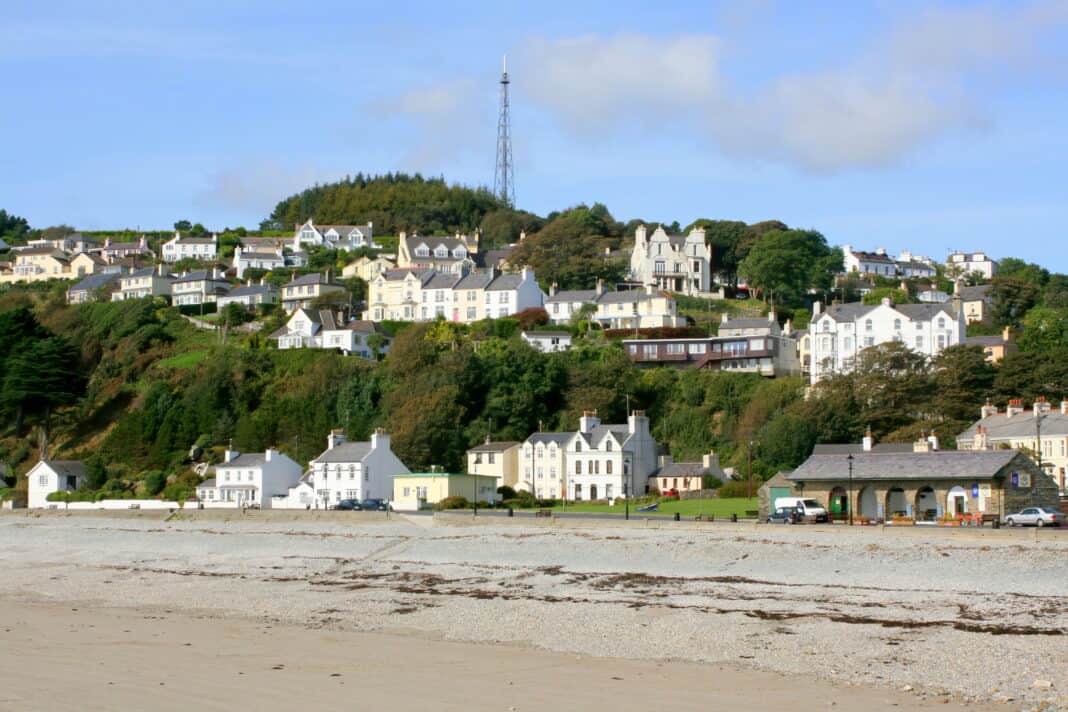
However, if you don’t have time and are only in Laxey as a stop off between trains, then there is a small café by the electric train station. You can grab some refreshments here and have a toilet break if you haven’t got time to venture too far between connections.
Alternatively, with any time you do have to spare, you could also go to the Great Laxey Mine Railway, the terminus of which is at Valley Gardens. On selected days, you can travel in a tiny carriage which is a replica of an old steam engine.
You are pulled along the narrow gauge track that used to carry lead and zinc from the mine. At a return fare of £2.50, you don’t travel very far; the train runs to the foot of the hill below the Great Laxey Wheel.
See the world’s largest operational water wheel
Another main attraction in Laxey is the Great Laxey Wheel. This is the largest original waterwheel in the world that is still operating and that was originally designed to pump water out of the mine.
The wheel, also known as Lady Isabella, has a diameter of 72 feet and 6 inches. During 2022, the wheel benefited from a massive conservation programme that included replacing defective timber on its buckets and mechanism.

Adults have to pay £13 to enter (children are free). For your entry fee you can learn about how the Laxey Miners lived and why the wheel is known as Lady Isabella, among other things. To top it off, you climb the spiral staircase to the top of the wheel, where you can get some wonderful views of the valley.
Go back in time on the Isle of Man Steam Railway
The Isle of Man Steam Railway dates back to Victorian times (the 1870s) and is another train line to add to your sightseeing list. The service runs south from Douglas Station to Port Erin on the island’s west coast. It also operates from mid-March to late October.
It’s not only a great way to get between some of the small towns on the island, it also gives you the chance to have a unique experience. You sit in old fashioned trains as they clatter through the countryside and can see the steam puffing out from the engine.
At various times of the year, you can also book special services in ‘The Dining Car’ that include, for example, afternoon tea or Sunday lunch.

The island used to have an extensive steam railway network, but sadly much of this has long gone. The remaining 15.5 mile line features some great attractions along the way, including the picturesque Castletown. You’ll find Castle Rushen, the Old House of Keys, and the Nautical Museum here.
The penultimate stop is Port St Mary, which has a lovely sandy beach and attractive townhouses overlooking the sea. The end of the line is Port Erin.
Explore Port Erin and the Railway Museum
If you are taking the Isle of Man Steam Railway, you will terminate at the small, picturesque town of Port Erin.
One of the top attractions here is the excellent Railway Museum right next to the steam railway’s station building. Inside you will find immaculately preserved locomotives and carriages dating back to the Victorian era.

The main exhibits also include old photographs and maps of the extensive network that once stretched across the Isle of Man. You can marvel at the wealth of stunning artefacts such as old tickets, advertising posters and handbills. If you have an explore ticket, entry to the museum is free.
Like Port St Mary, Port Erin has a fabulous beach and a sheltered harbour. You should spend some time wandering the seafront during your time here.
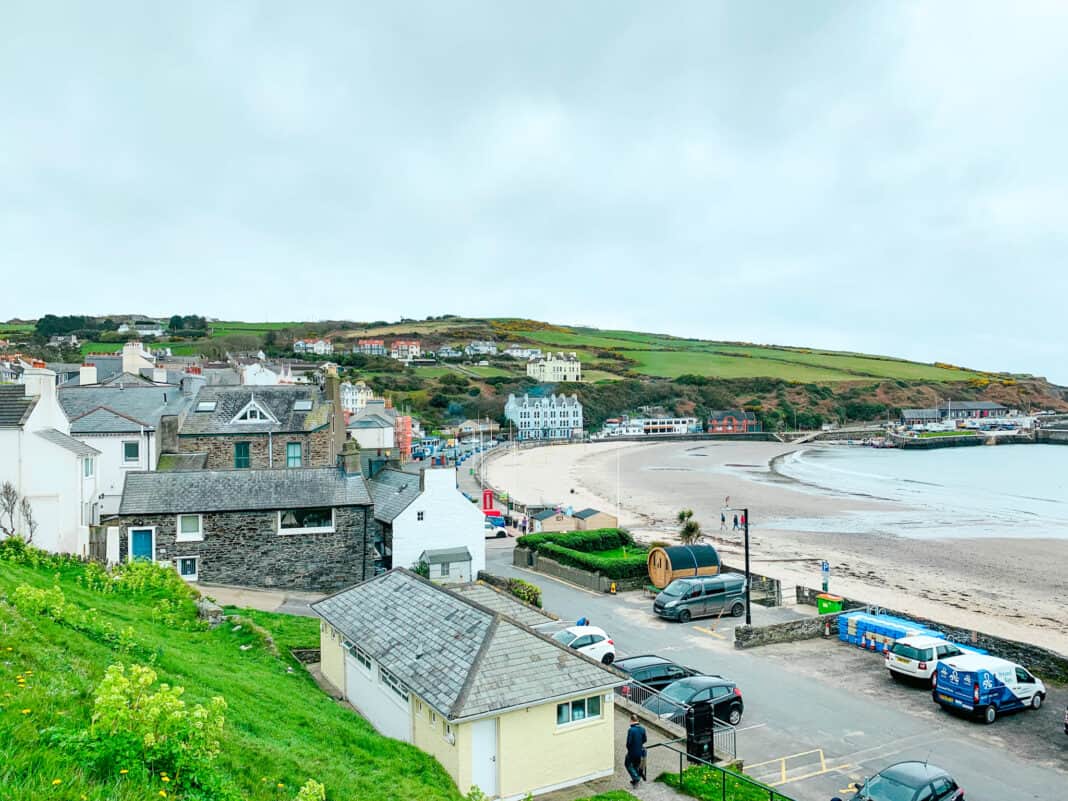
There’s also a great café in the station where you can grab something to eat and drink in a really cosy setting before getting the train back to Douglas or a stop-off on the way (try the white hot chocolate if you have a sweet tooth!).
If you are visiting when the Steam Railway isn’t running, Port Erin is well served by buses from Douglas, which include 1, 2, and 11. These all stop at Castletown on the way back to the capital.
Visit the island’s old capital
Another place to add to your things to do on the Isle of Man list is Castletown. A visit here is very easy to do when returning to Douglas from Port Erin, either by steam train or by bus. The latter stops right in the centre of town.
If arriving by train, this attractive seaside town (and the island’s capital until the second half of the 1800s) is only a short 5 to 10 minute walk from the station.
Castletown is dominated by one of the four heritage sites here: Castle Rushen, a beautifully preserved medieval fortress dating from the 12th century that sits in the town square and alongside the harbour.

It costs adults £13 to enter (kids get free entry) and it is open between April and October. There’s lots to see inside, including the gatehouse, medieval kitchen, and a 17th-century dining room. There are also great views of the town from the castle ramparts.
The three other heritage sites in Castletown include the Old House of Keys, where visitors can apparently observe a sitting in the former parliament. There is also the Old Grammar School and the Nautical Museum. Note that opening times for these sites are limited.
See Peel Castle
With the east coast of the Isle of Man serviced so well by heritage railway lines, it might be tempting to miss out on the island’s scenic west coast. However, if you have time to head west, add a visit to the town of Peel to your things to do in the Isle of Man. You can take several buses to get here, including the 5, 5A, 5C, 6 and 6A, from Douglas.
When we visited, it wasn’t possible to get off the bus at Peel’s harbour which is the best place to alight to explore the town. Instead, we got off further up the hill on Derby Road, but it wasn’t a long walk down to the picturesque seafront and harbour.
Peel offers several top attractions if you are visiting. There is the superb Peel Castle on St Patrick’s Isle which the Vikings initially built in the 11th century. If you cross the bridge from the seafront and then climb up the hill for a couple of minutes, you’ll get a lovely view back across to the castle and over a small tiny bay at the bottom of it.
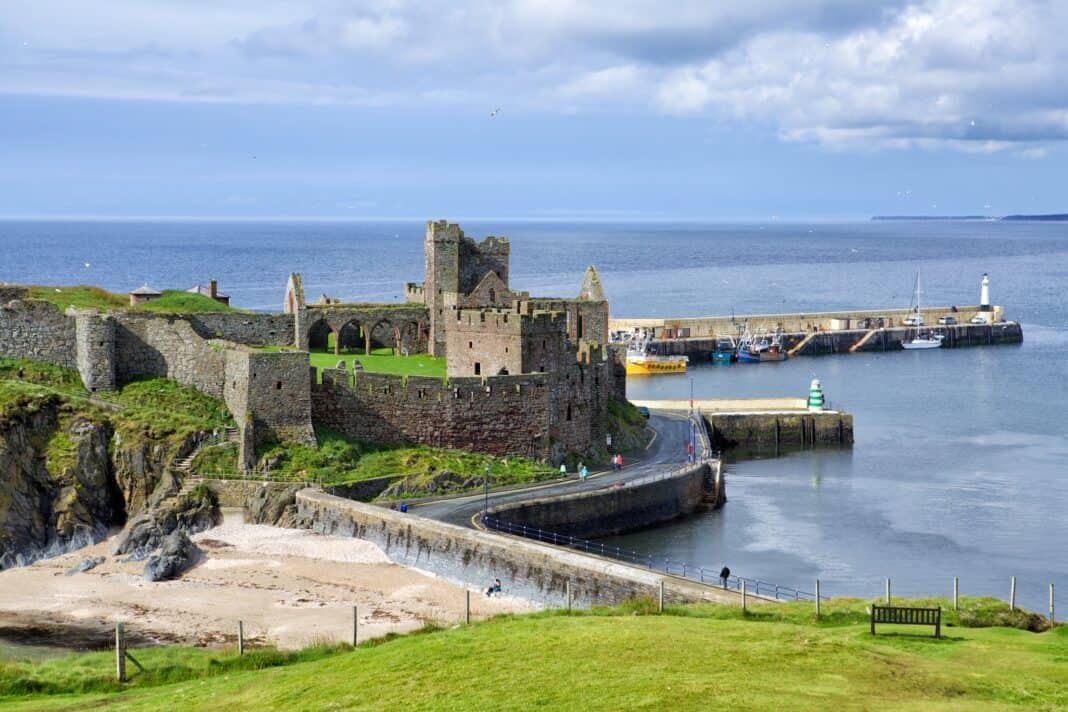
You can also go inside Peel Castle for an entrance fee of £8.
Learn about the Isle of Man and the Celts and Vikings
If you have time in Peel, you could also visit a museum.
Along the harbour front, there is the House of Manannan (Thie Vanannan in the Manx language), a museum named after the island’s mythological sea god. Inside you can find out about the island’s past, Peel town in the 19th century, and the influence of the Celts and Vikings.
It costs adults £13 to enter (children are free).
Go to the end of the electric line to Ramsey
If you’re riding the Manx Electric Railway, you can go all the way to the northern terminus in Ramsey. On the way, you pass through some lush and fertile countryside with flowers bursting into life in residents’ gardens during the spring.
Ramsey is an attractive town that boasts the Queen’s Pier and an interesting harbour area. Nearby, the town centre features some lovely areas, notably a small pretty town square.
The town has some attractions you might want to see if you have time. These include Mooragh Park, Fynoderee Distillery, and, on the outskirts, The Grove Museum of Victorian Life and Milntown House and Gardens.
If you fancy visiting Ramsey when the Manx Electric Railway isn’t running, you can get buses 3 and 3A from Douglas. There’s also the express X3 which runs inland rather than along the coastal route.
See the countryside and visit a glen
The Isle of Man is blessed with 18 national glens, according to the island’s government website. They are free to access, and anyone interested in adding this attraction to their list of things to do on the Isle of Man can enjoy beautiful scenery, including trees and forests, rock pools, and waterfalls.
However, if you take the Manx Electric Railway north to Ramsey, the first stop on the route is Groudle Glen. This stunning area of natural beauty features a small natural canyon called Lhen Coan in the Manx language (meaning Lonely Valley). You will also find a rich variety of trees, a small water wheel, and a pump house. So hop off here if you fancy visiting a glen.

Groudle Glen is also the hopping-off point to access the fabulous steam run Groudle Glen Railway. This takes you through the glen to the Isle of Man’s eastern coast.
Note that your Explore ticket will cover this, but other than a few specific days where, for example, the train runs Christmas or Easter themed journeys, the line is only open on Sundays and Wednesday evenings between early May and late September.
Learn about the island’s history in the Manx Museum
When planning out things to do on the Isle of Man, you may want to find out more about its fascinating history. If this is the case, one of the best places to go is the Manx Museum (Thie Tashtee Vannin in the Manx language) in Douglas, a short walk from the Gaiety Theatre.
Here you can learn about the island’s history and landscape as well as its role as a holiday destination and as the venue for the TT races. The museum also has the National Art Gallery. There is a mix of film, galleries, and interactive displays.
You can visit the Manx Museum every day from 9.30 to 4.30pm (except Christmas Day, Boxing Day, and New Year’s Day), and there is a gift shop where you can pick up a souvenir. It is free to go in, but there is a suggested donation of £10.
Take a coastal walk
The Isle of Man is a beautiful island and is a perfect place if you like the great outdoors. In particular, it has many walking trails for those who fancy taking a scenic walk along a coastal path.
You could consider taking the coast route to Derbyhaven (Raad ny Foillan in Manx). This route offers fabulous views back over Douglas Bay from Douglas Head. After that, you follow Marine Drive, the old coastal road, which ends in Port Soderick, a distance of 12.5 miles.
Or for a shorter walk, you could do the ‘Railway Ramble’. This is just over 4.5 miles and starts at Port Soderick and ends at the steam railway station in Douglas.
You can also book tours with private guides if you’d prefer. This trip includes a pick up and drop off to make it all the more easier.
See views of the island from the Great Union Camera Obscura
Located on a coastal footpath on Douglas Head overlooking Douglas Bay and the Isle of Man Sea Terminal, the Great Union Camera Obscura is a popular attraction to add to your things to do in the Isle of Man. It’s a great way to get some sweeping views of the island.
Built just before the start of the 20th century in the late 1890s, the camera has 11 lenses and a series of mirrors located above a darkened room. You can get incredible 360-degree panoramic views of the harbour, lighthouse, and the horizon towards England from here.
Admission is a reasonably priced £2.
Hit the beach
The Isle of Man is lucky enough to have many seaside towns, some of which have sandy beaches. So if you visit during the warm summer months, you’ll be able to spend some time on some of these relaxing on the sand and having a picnic or an ice cream by the sea.
This website provides more detail on the best beaches on the island. According to it, the best beach at the moment is the one in Ramsey. It also says that Ramsey is “one of the sunniest spots on the island”.
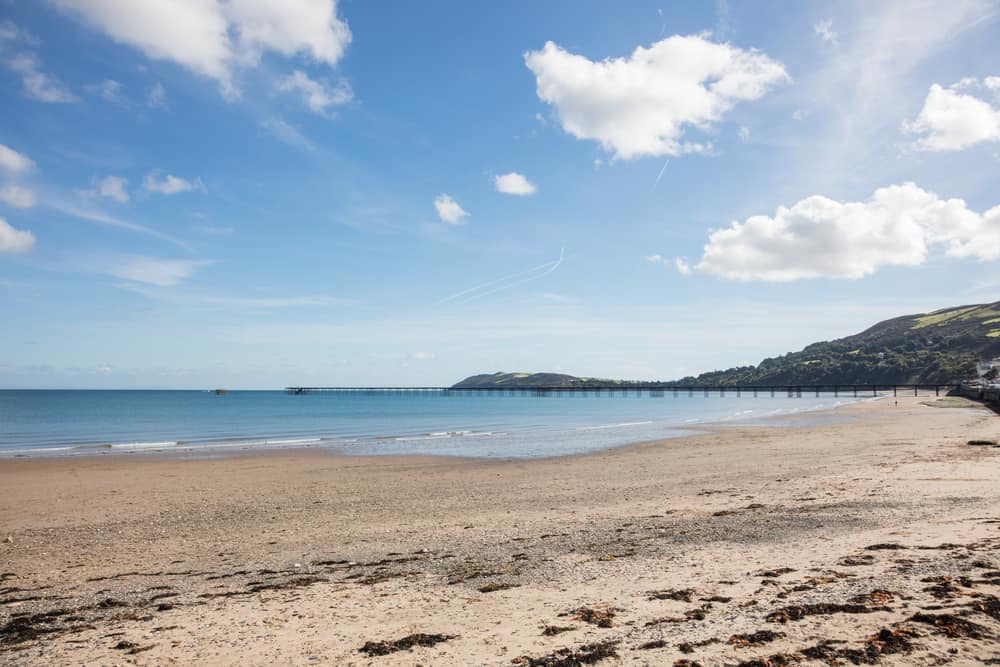
If you are riding on the various heritage railways or taking the bus, you can also combine a ride on these with a trip to the beach. There’s a beach in Port Erin, Peel, and Castletown, as well as Laxey Beach if you have time to spare before hopping onto the mountain railway.
Sail over to the Calf of Man Bird Observatory and Nature Reserve
A small island just off the main island’s south coast, the Calf of Man is somewhere you may want to also visit as part of your trip, especially if you are interested in ornithology.
Owned by Manx National Heritage, one of the main draws here is the Calf of Man Bird Observatory and the tiny island’s natural reserve. There are said to be 30 odd species of birds that breed here annually.
If you fancy getting a boat over to the Calf of Man and visiting the bird sanctuary, several small boat operators run return trips from Port Erin and Port St Mary. Note that these must be booked in advance and are subject to the weather, the tide, and when boatmen are available to make the crossing.
Stroll through the Tynwald National Park and Arboretum
Only a few miles outside Peel on the road to Douglas near Ballacraine, you will find the Tynwald National Park and Arboretum.
Intriguingly, Iceland’s then President opened the park in the late 1970s. It covers around 25 acres and is divided into different sections over which you can see a pond, ornamental trees and shrubs, native tree species, and a picnic area. You can easily access the park by bus as quite a few service the route that passes by it.
See the animals at the Curraghs Wildlife Park
This small wildlife park is in the northwest of the island, which you pass when you get the bus (numbers 5, 5A, and 6A) from Ramsey across the island to Peel.
Curraghs Wildlife Park is open seven days a week. On a visit here, you can see a great variety of animals, including owls, black spider monkeys, Brazilian tapirs, capybaras, meerkats, red pandas, flamingos, and yellow mongoose.
For an extra treat, you can also book experiences where you can get up close to and feed some of the ainimals. Or if you’re in the park at certain times, you can see some of animals being fed (e.g. there is meerkat feeding at 2 pm and penguin feeding at 11 am and 3 pm).
Look out at the Tower of Refuge
If you walk the short distance to the seafront from the Bee Gees statue at the south end of Douglas Promenade, you’ll spot the round Tower of Refuge straddling St Mary’s Isle in Douglas Bay. Although the stone structure may look ancient, it was, in fact, built in the mid-19th century.
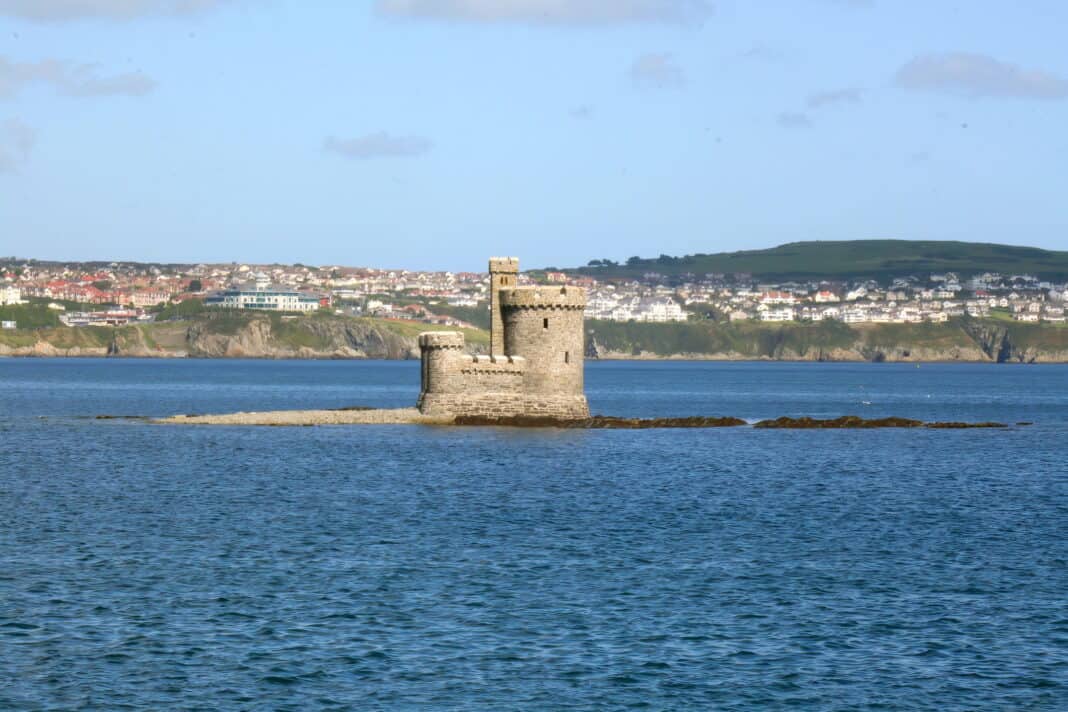
You might be curious to know why the tower was constructed in such an unusual spot in the bay, especially as part of it appears to be submerged at high tide. This is because the structure was intended to provide shelter for stranded sailors whose ships had broken up on this rocky outcrop (also known as Conister Rock) until help arrived.
Spot the famous people in Douglas
Actor and comedian Norman Wisdom lived on the Isle of Man for more than 30 years. He apparently was a fan of the Sefton Hotel next to the Gaiety Theatre in Douglas, so much so that the hotel bar was named Sir Norman’s in his honour.
You can pop in here for a drink and see some of the photos hanging on the wall – there is one of him alongside Laurel and Hardy dating from their early 1950s British tour. Or perhaps take a snap of yourself alongside the seated statue of him on a bench at the entrance.
Also along the promenade in Douglas is a statue of the three brothers who found fame as The Bee Gees. The brothers were born here, and a statue has been erected at the south end of Douglas (Loch) Promenade.

Feed the horses at the Home of Rest of Old Horses
The Home of Rest of Old Horses is an excellent place for anyone who loves horses and is another attraction on the island that is free to go into. Located in the southwest of Douglas, you can visit the home where working horses come for retirement.
Founded by two sisters in the 1950s, the original idea was to take care of horses after they were no longer needed to carry out work and their owners couldn’t afford to keep them. There are now almost 60 horses here, as well as 15 donkeys that you can stroke and feed (you can buy food at the gift shop). Animal lovers can even sponsor a few of the horses.
The rest home is on the main road between Douglas and the airport. You can reach it easily via several different buses (1, 1A, 1H, 2, 2A, 11, and 11A).
Marvel at the motorcycles at the A.R.E. Motorcycle Museum
As you might expect, this fascinating museum is situated on part of the TT motorbike racing circuit. The A.R.E Motorcycle Museum is on the road between Ramsey and Peel in the northwest of the Isle of Man, at Kirk Michael.
Run by motorcycle enthusiasts, the collection numbers more than 100 bikes, many of which are 1930s models. These include Triumphs, Moto Guzzis, and Vincents.
As the museum is on the grounds of an old vicarage, access is limited, so visitors are advised to check if it is possible to see the collection before setting off for it. It is open between Easter and the end of September, and you can go in for free.
Get out on the water
The Isle of Man offers some terrific coastline views, and the surrounding Irish Sea is home to rich marine wildlife. For those of you who fancy taking to the water for an entirely different experience from exploring on land, the Isle of Man offers some excellent options for a boat trip.
You can take a pleasure cruise, wildlife tour, or a fishing trip if you are a seasoned angler. You can pick up a boat from several spots on the island, and this website provides more details on what is on offer.
The best time to visit the Isle of Man
As the climate is temperate, it is possible to visit the Isle of Man all year round. That said, the island is probably best enjoyed when the weather is good.
During the summer
The best time of year to go is therefore May through to mid-September because this is when you are most likely to experience good weather. This will also mean you can experience the heritage lines, which tend to run between mid-March and October.
On bright, clear, sunny days and when there are warm temperatures, you will be rewarded with amazing views from the summit of Snaefell. You’ll also be able to look out over the picturesque landscape from your seat on the different heritage railway lines.
Over the autumn months
Although the summer months might be the best time to visit, the Isle of Man visitors’ site also recommends going in the autumn when it’s quieter, and the seasonal change adds some autumnal colour to the scenery.
To coincide with the TT races
Another thing to be aware of when booking your short trip is that the island hosts its annual TT motorbike race over a two week period from late May to mid-June. This popular event inevitably pushes up accommodation costs. It also limits your movements on the island, as some major roads are closed when the racing is taking place.
However, this may be something that you fancy attending as a spectator, so you will want to book far in advance to ensure you have accommodation.
Finally, it’s also worth noting that based on our experience, some eateries and shops seem to be closed on public holidays. Although this doesn’t tend to affect transportation, it is important to consider this if you are looking to make connections between the different heritage railway lines (i.e. the Steam Railway only runs a certain number of times a day) and need to get back to Douglas at the end of the day if this is where you base yourself.
Other short breaks in the UK
If you like exploring the UK, then check out some of my other posts.
If you like exploring small islands, then you might be particularly interested in my posts on Guernsey, Sark, and Jersey in the Channel Islands.
I have also written about several places in the south west of England that are absolutely fabulous places for a short visit and you may if enjoy if you like wonderful coastal places:



